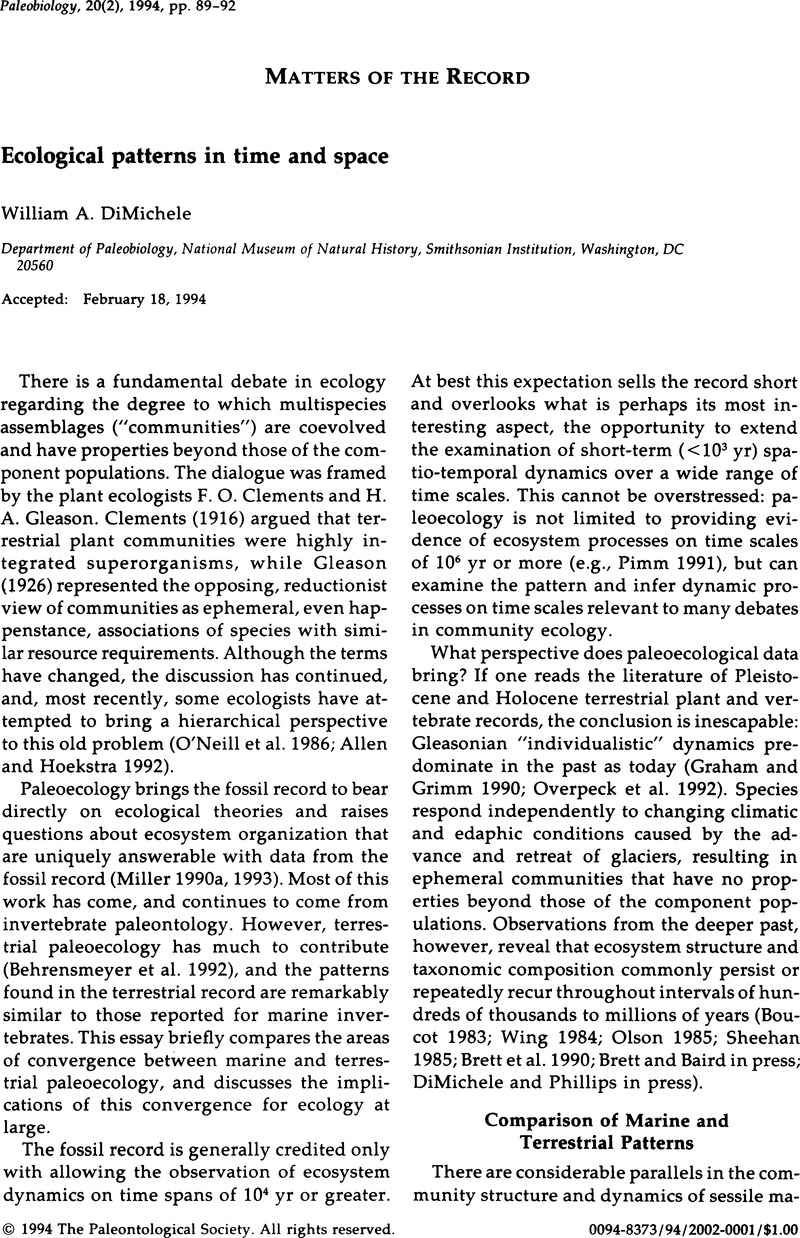Crossref Citations
This article has been cited by the following publications. This list is generated based on data provided by Crossref.
Valkenburgh, Blaire Van
1995.
Tracking ecology over geological time: evolution within guilds of vertebrates.
Trends in Ecology & Evolution,
Vol. 10,
Issue. 2,
p.
71.
Enquist, Brian J.
Jordan, Mark A.
and
Brown, James H.
1995.
Connections between ecology, biogeography, and paleobiology: Relationship between local abundance and geographic distribution in fossil and recent molluscs.
Evolutionary Ecology,
Vol. 9,
Issue. 6,
p.
586.
Brett, Carlton E.
Ivany, Linda C.
and
Schopf, Kenneth M.
1996.
Coordinated stasis: An overview.
Palaeogeography, Palaeoclimatology, Palaeoecology,
Vol. 127,
Issue. 1-4,
p.
1.
Riddle, Brett R.
1996.
The molecular phylogeographic bridge between deep and shallow history in continental biotas.
Trends in Ecology & Evolution,
Vol. 11,
Issue. 5,
p.
207.
Schopf, Kenneth M.
1996.
Coordinated stasis: biofacies revisited and the conceptual modeling of whole-fauna dynamics.
Palaeogeography, Palaeoclimatology, Palaeoecology,
Vol. 127,
Issue. 1-4,
p.
157.
Holterhoff, Peter F.
1996.
Crinoid biofacies in Upper Carboniferous cyclothems, midcontinent North America: faunal tracking and the role of regional processes in biofacies recurrence.
Palaeogeography, Palaeoclimatology, Palaeoecology,
Vol. 127,
Issue. 1-4,
p.
47.
Miller, William
1996.
Ecology of coordinated stasis.
Palaeogeography, Palaeoclimatology, Palaeoecology,
Vol. 127,
Issue. 1-4,
p.
177.
Zi-qiang, Wang
1996.
Recovery of vegetation from the terminal Permian mass extinction in North China.
Review of Palaeobotany and Palynology,
Vol. 91,
Issue. 1-4,
p.
121.
Mcgowran, Brian
and
Li, Qianyu
1996.
Ecostratigraphy and sequence biostratigraphy, with a neritic foraminiferal example from the Miocene in Southern Australia.
Historical Biology,
Vol. 11,
Issue. 1-4,
p.
137.
Sheldon, Peter R.
1996.
Plus ça change — a model for stasis and evolution in different environments.
Palaeogeography, Palaeoclimatology, Palaeoecology,
Vol. 127,
Issue. 1-4,
p.
209.
Pandolfi, John M.
1996.
Limited membership in Pleistocene reef coral assemblages from the Huon Peninsula, Papua New Guinea: constancy during global change.
Paleobiology,
Vol. 22,
Issue. 2,
p.
152.
Alroy, John
1996.
Constant extinction, constrained diversification, and uncoordinated stasis in North American mammals.
Palaeogeography, Palaeoclimatology, Palaeoecology,
Vol. 127,
Issue. 1-4,
p.
285.
Aronson, Richard B.
and
Precht, William F.
1997.
Stasis, biological disturbance, and community structure of a Holocene coral reef.
Paleobiology,
Vol. 23,
Issue. 3,
p.
326.
Miller, Arnold I.
1997.
Coordinated stasis or coincident relative stability?.
Paleobiology,
Vol. 23,
Issue. 2,
p.
155.
Patzkowsky, Mark E.
and
Holland, Steven M.
1997.
Patterns of turnover in Middle and Upper Ordovician brachiopods of the eastern United States: a test of coordinated stasis.
Paleobiology,
Vol. 23,
Issue. 4,
p.
420.
DiMichele, William A.
and
Phillips, Tom L.
1997.
Climate change, plant extinctions and vegetational recovery during the Middle-Late Pennsylvanian Transition: the Case of tropical peat-forming environments in North America.
Geological Society, London, Special Publications,
Vol. 102,
Issue. 1,
p.
201.
Lu, Gangyi
Keller, Gerta
and
Pardo, Alfonso
1998.
Stability and change in Tethyan planktic foraminifera across the Paleocene–Eocene transition.
Marine Micropaleontology,
Vol. 35,
Issue. 3-4,
p.
203.
Magurran, A. E.
May, R. M.
and
Morris, S. Conway
1998.
The evolution of diversity in ancient ecosystems: a review.
Philosophical Transactions of the Royal Society of London. Series B: Biological Sciences,
Vol. 353,
Issue. 1366,
p.
327.
Jackson, Stephen T.
2000.
Out of the Garden and into the Cooler? A Quaternary Perspective on Deep-Time Paleoecology.
The Paleontological Society Papers,
Vol. 6,
Issue. ,
p.
287.
Sterelny, Kim
2001.
The Reality of Ecological Assemblages: A Palaeo-ecological Puzzle.
Biology & Philosophy,
Vol. 16,
Issue. 4,
p.
437.



